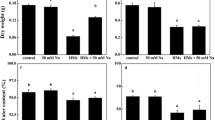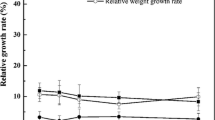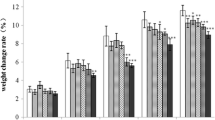Abstract
The rare earth elements are increasingly being used as trace supplements in different fields. In this study, subcellular distribution, the chemical forms and toxicity of cerium (Ce) were evaluated for Elodea canadensis. The effect of Ce (5–20 mg L−1) applied for 7 days was assessed by measuring changes in the nutrient elements, photosynthetic pigments, malondialdehyde and antioxidant systems. Ce accumulation was greatest in the cell walls, followed by the organelles and the soluble fraction. Ce levels were higher in cellulose and pectin than in other biomacromolecules. The toxic effects caused by Ce were shown by a reduction in photosynthetic pigments, disruption of nutrient elements, and increases in MDA content. E. canadensis shows Ce-induced oxidative stress by modulating antioxidant enzymes, such as guaiacol peroxidase and catalase. Elevated Ce levels may represent a potential risk for aquatic ecosystems.



Similar content being viewed by others
References
Axtell NR, Sternberg SPK, Claussen K (2003) Lead and nickel removal using Microspora and Lemna minor. Bioresour Technol 89:41–48
Barry MJ, Meehan BJ (2000) The acute and chronic toxicity of lanthanum to Daphnia carinata. Chemosphere 41:1669–1674
Bowmer KH, Jacobs SWL, Sainty GR (1995) Identification, biology and management of Elodea canadensis, Hydrocharitaceae. J Aquat Plant Manag 33:13–19
Cho DY, Lee S, Park S, Chung A (1994) Studies on the biosorption of heavy metals onto Chlorella vulgaris. J Environ Sci Health A 29:389–409
Dalla Vecchia F, Rocca NL, Moro I, De Faveri S, Andreoli C, Rascio N (2005) Morphogenetic, ultrastructural and physiological damages suffered by submerged leaves of Elodea canadensis exposed to cadmium. Plant Sci 168:329–338
Dia A, Gruau G, Olivié-Lauquet G, Riou C, Molénat J, Curmi P (2000) The distribution of rare earth elements in groundwaters: assessing the role of source-rock composition, redox changes and colloidal particles. Geochim Cosmochim Acta 64:4131–4151
Diatloff E, Smith FW (1995) Rare earth elements and plant growth: I. Effects of lanthanum and cerium on root elongation of corn and mungbean. J Plant Nutr 18:1963–1976
Fritioff Å, Greger M (2007) Fate of cadmium in Elodea canadensis. Chemosphere 67:265–375
Góth L (1991) A simple method for determination of serum catalase and revision of reference range. Clin Chim Acta 196:143–152
Guo XS, Zhou Q, Lu TH, Dang M, Huang XH (2007) Distribution and Translocation of 141Ce (III) in horseradish. Ann Bot 100:1459–1465
He YW, Loh CS (2000) Cerium and lanthanum promote floral initiation and reproductive growth of Arabidopsis thaliana. Plant Sci 159:117–124
Heath RL, Packer L (1968) Photoperoxidation in isolated chloroplasts I. Kinetic and stoichiometry of fatty acid peroxidation. Arch Biochem Biophys 125:189–198
Hu X, Ding ZH, Chen YJ, Wang XR, Dai LM (2002) Bioaccumulation of lanthanum and cerium and their effects on the growth of wheat (Triticum aestivum L.) seedlings. Chemosphere 48:621–629
Hu Z, Richter H, Sparovek G, Schnug E (2004) Physiological and biochemical effects of rare earth elements on plants and their agricultural significance: a review. J Plant Nutr 27:183–220
Ippolito MP, Fasciano C, d’Aquino L, Morgana M, Tommasi F (2010) Responses of antioxidant systems after exposition to rare earths and their role in chilling stress in common duckweed (Lemna minor L.): a defensive weapon or a boomerang? Arch Environ Contam Toxicol 58:42–52
Iqbal M, Saeed A, Zafar SI (2009) FTIR spectrophotometry, kinetics and adsorption isotherms modeling, ion exchange, and EDX analysis for understanding the mechanism of Cd2+ and Pb2+ removal by mango peel waste. J Hazard Mater 164:161–171
Kähkönen MA, Pantsar-Kallio M, Manninen PKG (1997) Analysing heavy metal concentrations in the different parts of Elodea canadensis and surface sediment with PCA in two boreal lakes in southern Finland. Chemosphere 35:2645–2656
Keskinkan O, Goksu MZL, Yuceer A, Basibuyuk M, Forster CF (2003) Heavy metal adsorption characteristics of a submerged aquatic plant (Myriophyllum spicatum). Process Biochem 39:179–183
Kobayashi Y, Ikka T, Kinura K, Yasuda O, Koyama H (2007) Characterisation of lanthanum toxicity for root growth of Arabidopsis thaliana from the aspect of natural genetic variation. Funct Plant Biol 34:984–994
Kraus TE, Fletcher RA (1994) Paclobutrazol protects wheat seedlings from heat and paraquat injury. Is detoxification of active oxygen involved? Plant Cell Physiol 35:45–52
Lai Y, Wang QQ, Yang LM, Huang BL (2006) Subcellular distribution of rare earth elements and characterization of their binding species in a newly discovered hyperaccumulator Pronephrium simplex. Talanta 70:26–31
Li YH, Yan CL, Liu JC, Chen YH, Hu J, Xue B (2003) Effects of La3+ on ATPase activities of plasma membrane vesicles isolated from Casuarina equisetifolia seedlings under acid rain stress. J Rare Earth 21:675–679
Lichtenthaler HK (1987) Chlorophylls and carotenoids: pigments of photosynthetic membranes. Method Enzymol 148:350–382
Mal TK, Adorjan P, Corbett AL (2002) Effect of copper on growth of an aquatic macrophyte, Elodea canadensis. Environ Pollut 120:307–311
Mittler R (2002) Oxidative stress, antioxidants and stress tolerance. Trends Plant Sci 7:405–410
Mohan BS, Hosetti BB (2006) Phytotoxicity of cadmium on the physiological dynamics of Salvinia natans L. grown in macrophyte ponds. J Environ Biol 27:701–704
Nakano Y, Asada K (1981) Hydrogen peroxide is scavenged by ascorbate-specific peroxidase in spinach chloroplasts. Plant Cell Physiol 22:867–880
National Natural Science Foundation of China (1996) Environmental chemistry. Science Press, Beijing
Nyquist G, Greger M (2007) Uptake of Zn, Cu and Cd in metal loaded Elodea canadensis. Environ Exp Bot 60:219–226
Ōyanagui Y (1984) Reevaluation of assay methods and establishment of kit for superoxide dismutase activity. Anal Biochem 142:290–296
Protano G, Riccobono F (2002) High contents of rare earth elements (REEs) in stream waters of a Cu–Pb–Zn mining area. Environ Pollut 117:499–514
Rakhshaee R, Giahi M, Pourahmad A (2009) Studying effect of cell wall’s carboxyl–carboxylate ratio change of Lemna minor to remove heavy metals from aqueous solution. J Hazard Mater 163:165–173
Ruíz-Herrera LF, Sánchez-Calderón L, Herrera-Estrella L, López-Bucio J (2012) Rare earth elements lanthanum and gadolinium induce phosphate-deficiency responses in Arabidopsis thaliana seedlings. Plant Soil 353:231–247
Shan XQ, Wang HO, Zhang SZ, Zhou HF, Zheng Y, Yu H, Wen B (2003) Accumulation and uptake of light rare earth elements in a hyperaccumulator Dicranopteris dichotoma. Plant Sci 165:1343–1353
Tanaka K, Sano T, Ishizuka K, Kitta K, Kawamura Y (1994) Comparison of properties of leaf and root glutathione reductases from spinach. Physiol Plant 91:353–358
Thiébaut G, Gross Y, Gierlinski P, Boiché A (2010) Accumulation of metals in Elodea canadensis and Elodea nuttallii: implications for plant-macroinvertebrate interactions. Sci Total Environ 408:5499–5505
Wang AG, Luo GH (1990) Quantitative relation between the reaction of hydroxylamine and superoxide anion radicals in plants. Plant Physiol Commun 6:55–57
Wang X, Shi GX, Xu QS, Xu BJ, Zhao J (2007) Lanthanum- and cerium-induced oxidative stress in submerged Hydrilla verticillata plants. Russ J Plant Physl 54:693–697
Wang LH, Huang XH, Zhou Q (2008) Effects of rare earth elements on the distribution of mineral elements and heavy metals in horseradish. Chemosphere 73:314–319
Xiong J, An LY, Lu H, Zhu C (2009) Exogenous nitric oxide enhances cadmium tolerance of rice by increasing pectin and hemicellulose contents in root cell wall. Planta 230:755–765
Xu QS, Fu YY, Min HL, Cai SJ, Sha S, Cheng GY (2012) Laboratory assessment of uptake and toxicity of lanthanum (La) in the leaves of Hydrocharis dubia (Bl.) Backer. Environ Sci Pollut Res 19:3950–3958
Yang XY, Yin DQ, Sun H, Wang XR, Dai LM, Chen YJ, Cao M (1999) Distribution and bioavailability of rare earth elements in aquatic microcosm. Chemosphere 39:2443–2450
Zhang J, Liu CQ (2004) Major and rare earth elements in rainwaters from Japan and East China Sea: natural and anthropogenic sources. Chem Geol 209:315–326
Zhu WF, Xu SQ, Zhang H, Shao PP, Wu DS, Yang WJ, Feng J (1996) Investigation on the intelligence quotient of children in the areas with high REE background (I)-REE bioeffects in the REE-high areas of southern Jiangxi province. Chin Sci Bull 41:1977–1981
Zhu W, Kennedy M, de Leer EWB, Zhou H, Alaerts GJFR (1997) Distribution and modeling of rare earth elements in Chinese river sediments. Sci Total Environ 204:233–243
Acknowledgments
This research was supported by the National Natural Science Foundation of China (No. 31170162), A Project Funded by the Priority Academic Program Development of Jiangsu Higher Education Institutions (PAPD) and sponsored by Qing Lan Project. Ce samples were analyzed by Nanjing Normal University Center for Analysis and Testing.
Author information
Authors and Affiliations
Corresponding author
Additional information
Communicated by A. Krolicka.
Rights and permissions
About this article
Cite this article
Chu, W.Y., Cai, S.J., Fu, Y.Y. et al. The toxicity of cerium nitrate to Elodea canadensis: subcellular distribution, chemical forms and physiological effects. Acta Physiol Plant 36, 2491–2499 (2014). https://doi.org/10.1007/s11738-014-1622-9
Received:
Revised:
Accepted:
Published:
Issue Date:
DOI: https://doi.org/10.1007/s11738-014-1622-9




